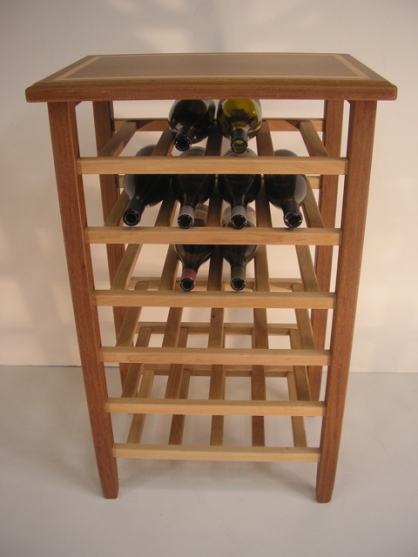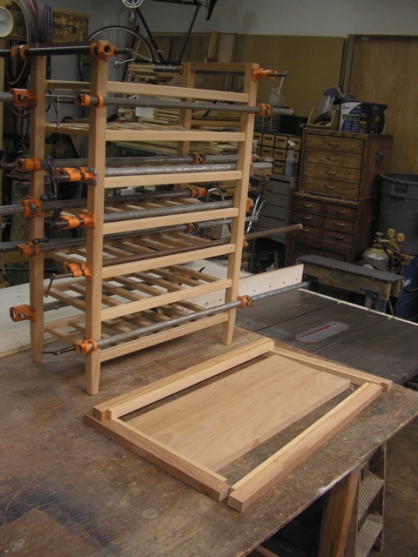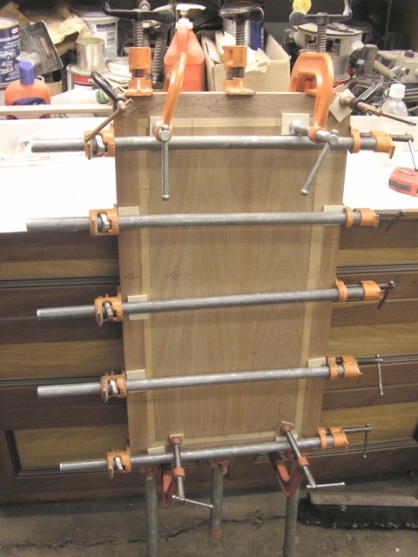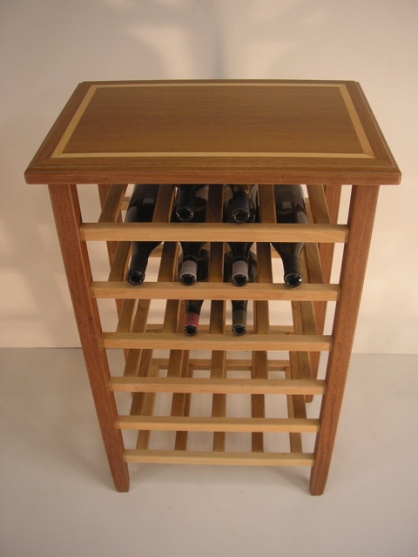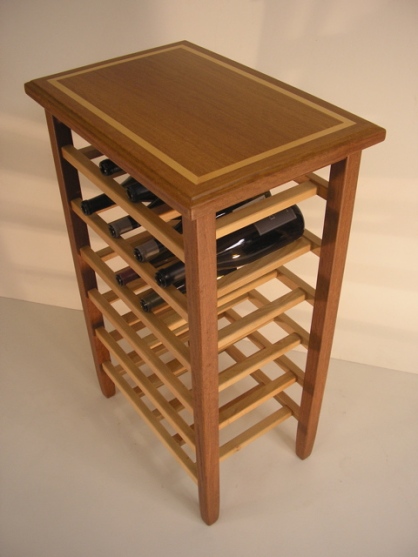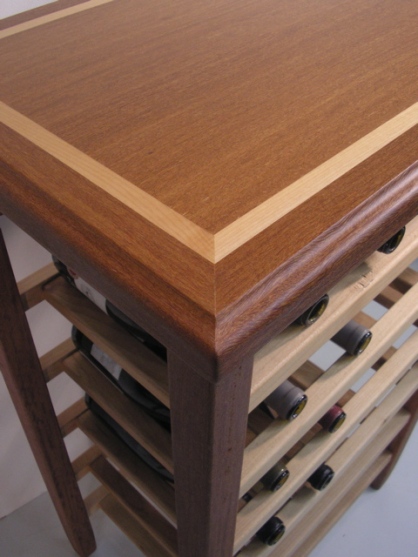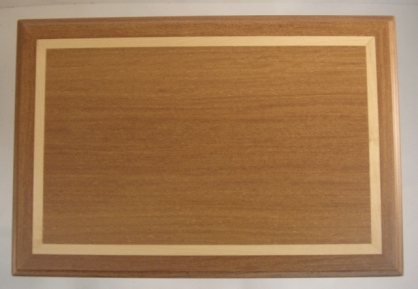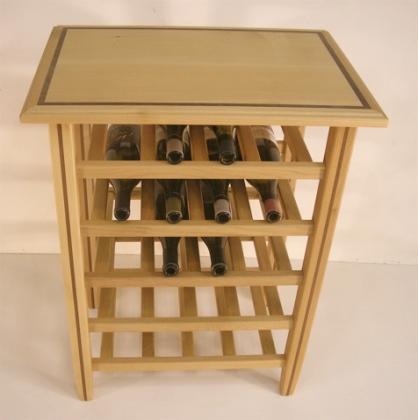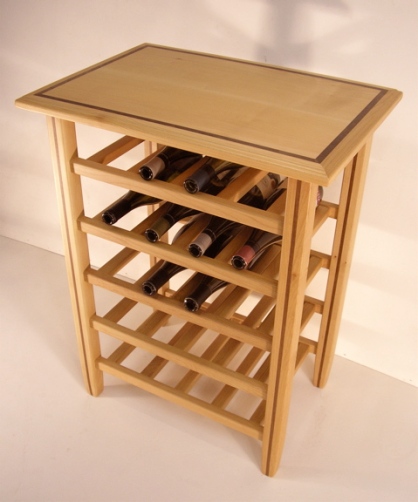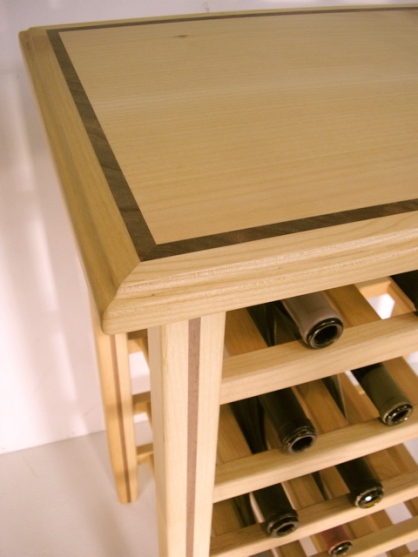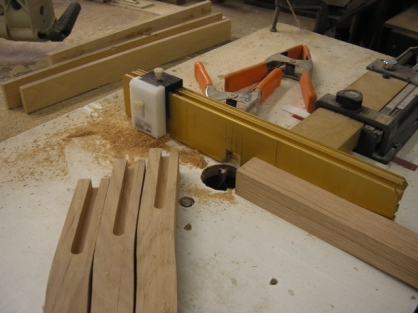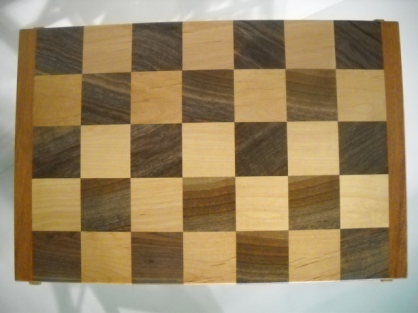Wine Tables, Wine Racks, Made In Oregon!
May 2, 2011
This rack was made from Machiche a very dense, hard, tropical lumber from Central America (sometime called Black cabbage-bark). The racks and feature strips in the mitered edge band on the tops is Alder from Oregon.
The dimensions are 23 1/2″ wide, 15 1/2″ deep and 37″ tall. The field here for the top was assembled from a piece of lumber that was cross-cut in two and folded back on itself. The edge band was cut from the same board so the color would remain consistent.
This Machiche is very hard and seems kind of brittle too, but it also seems dimensionally stable, resistant to expansion and contraction due to changing moisture in the air.
The grain is very beautiful. It’s subtle because at a distance it just seems to have a rich dark color, but up close the grain has a wonderful curly pattern.
The top turned out great. The glue joint is virtually invisible. It’s so cool when things turn out better or different from the way I envisioned them. I think the contrast with the light Alder wood turned out great. I love it when wood seems to have a golden glow to it.
I try as hard as I can to make each piece as well as I can. But still I make small mistakes and I’m working wood with it’s own challenges. No matter how much time or effort I put forth, things are never perfect, so I just do my best, work as quickly as I can, and try to get my kicks making different stuff from what ever material comes my way.
I always expect things to go wrong, because they already have so many times throughout each step of the process. Sometimes, I walk into the shop the morning after applying the final coat of clear finish the night before, and look at my pieces with kind of a detached amazement. Then it all comes back to me… oh yeah that was some idea I had way last month. I looked at some boards and thought I should see what would happen if I did this or that.
It’s great when I can think to myself… that turned out pretty good. So now, #0511 needs a good home and worthy bottles of wine to proudly display!
Knot another wine rack!
February 16, 2011
Yeah, another one. My neighbors who make custom upholstered furniture gave me a bunch of Alder scraps a few months ago. Every month or so, they get a unit of FSC Alder lumber and proceed to make piles of narrow rips and other scraps, perfect for me to mill into rack parts.
I generally try to make parts production style so I can efficiently produce two to four or five racks at a time. This one was cut out along with the rack on my last posting. My deal is to try making all my stuff out of solid wood and not glued up… if I can. It irritates me to look at production furniture and cabinets that boast solid wood, only to see glue joints everywhere.
As I have said before, it would be easy to draw ideas up, go to the lumber yard, buy a bunch of nice material and make cool stuff. The problem is that it costs money. If I could find ways to sell these things and recover that cost, I would be cranking out wild stuff from the many pages I’ve sketched in my design note books.
Sometimes I can find big enough pieces to make solid legs, but in this case, the scraps were wide and long enough, but not thick enough. To solve that, I laminate a different kind of wood so it becomes a part of the design, not just a way to use thinner (cheaper) material, like the typical manufacturing process. In the end, it’s no doubt cheaper, easier, to buy thicker 8/4 material for the legs, but like I said, it cost money. I have way more time than money. I began laminating parts so that they becomes part of the design and look on purpose. In this case, Oregon Black Walnut milled from some logs I dried.
The field for the tops are usually two pieces glued up, either book matched or a single board folded back on itself at the cut, so that the grain matches and many times make the joint invisible. I started using a contrasting feature strip when I laminate the tops for the same reason… make big parts out of small pieces and have the laminations be part of the design.
Knot normally the way I do it…
February 10, 2011
A lady saw photos of a wine rack I posted for sale on craigslist and contacted me. I invited her to the shop to see what different pieces I have in my inventory. She had a corner in her dining room where she wanted to place it and we discussed dimensions.
She looked at completed racks and I explained how the modular nature effected the over all dimensions. She gravitated to a piece that was constructed from Black Walnut and Sapele, and said she really liked the redish color of the Sapele… also know as African Mahogany. She ask what color of stain I used.
I had to laugh and said that there was no stain, I use different hardwoods to show off their natural color. There is no reason to use a stain. I do however use stains on the pieces I make out of soft wood like Pine, Fir or Cedar. I showed her a couple of those different pieces and some raw wood to illustrate how washed out the natural wood looks generally. She wanted, if not to match, at least compliment her dining room table.
She ask how much the Walnut/Sapele piece was and I said it was three times as expensive as the Fir/Pine ones. It was too small for her but she really liked it. I had to laugh again. I said, you have good taste, your like my wife. She sees a red car and says, wow that is a beautiful car, I want one of those. I say, baby you have good taste… that is a Ferarri. How about that red car over there? No, I don’t like that so much. Well Babe, that’s a Toyota.
I had three racks made from Alder that were recently glued up but I had not made tops for yet. They were the right dimension and bottle capacity for her. I showed her the two most common tops I make… Mitered edge band, with or without a contrasting feature strip, and the Breadboard style with through tenon joint.
She liked the Breadboard style, saying that the way I leave the tenon protruding matched her table’s styling. I told her that I never stain hardwoods, but that furniture manufacturers routinely apply stains to Alder. I pulled out my drawer full of sample stain cans and proceeded to wipe stain on some Alder scraps. The first one or two colors were spot on for her. So I made a Breadboard top, stained the piece and applied three coats of polyurethane.
She picked it up yesterday and said it looked great. As much as I would love to be purist, use highly figured exotic woods and tradition oil and wax finishes… I’m not a snob. In the real world, it’s only other woodworkers that really know the difference between a Ferrari and a Toyota… or care. While it’s Knot normally how I do things, it pays the bills. I did like the way it turned out and more importantly so did she. Thanks for the support… another one goes to a good home.
Knot a Wine Rack…
January 16, 2011
It has been about a year since I started this blog. 2010 was one of the worst years I have lived through. Almost nothing went right, I never caught a break and almost every single thing I tried to do, blew up in my face. I feel like a complete failure.
Having said that, I’m not alone. It was hard for almost everybody I talk with. I got a message from WordPress telling me enough people viewed my blog to fill two 747 air planes. Lot of good it did. I got very few comments and even less interest in my wine racks. It’s very disapointing and some what frustrating.
I’m going to try an keep the shop going, but I don’t see how. I don’t have any emotional attachment to it really. Carpentry and wood working is what I have been doing for a living for a long time and I don’t really know what else to do. I going to try and keep going until I can’t anymore. I enjoy the work but it’s not who I am or what I’m about as a person, just a way to try and make money.
This is a piece I built last month for a lady. It is to be used as a night stand. The shelves are for shoes and slippers. She gave me some rough idea of dimensions that would fit in the room and how high it should be for a reading lamp.
I looked through my piles of hardwood lumber and dried logs, but there wasn’t enough to make all the parts I needed in the sizes I wanted. Here is a shot of some Clear Verticle Grain Fir that I re sawed. It came out of a nasty looking old 6 x 12 beam, salvaged from a construction site. While it had some defects and a big knot, it is beautiful material.
It must have been a giant old growth tree by the close growth rings and how many there are. I’m always in awe when I think that every grain was a year… we must be looking at decades… generations to grow this tree.
Here is what’s left of a 2 x 12 somebody gave me fifteen years ago. It has some curly grain to it that is very delicate and most gorgeous. I used it for the legs and the laminated edge-band on the top.
I love the look and color of fir. It is very difficult to work with because it can be splintery and it’s not hard enough to resist dings and dents in furniture. I went with it anyway because it was free. Here are a bunch of parts and you can see that I cut the drawer fronts out of the face frame and glued it back together so that the grain would run through.
Here I am with the tenon cutting machine I built, making round tenons to join the legs with the shelves. I call it the pencil sharpener, because it’s like sharpening big pencils.
When working with fir, you need to have very sharp blades, bits and planer knives or else you get heart breaking tear out or splinters. Sometimes you may run a bunch of pieces through the router table very carefully and think you have it licked… then WHAM, a blow out that rips the piece apart so that the material is wasted.
There are tricks to dealing with this like “Climb Cutting” where you run the work backwards agains the bit so it doesn’t grab the splintery grain…. or making multiple passes, taking a small amount at a time… or both. But, still you never know when the fir will bite you.
I was lucky this time, because I used every trick I know to machine all these parts right the first time. I barely had enough material to design this piece and no spare boards for mistakes and mishaps. In the end, there was barely enough scrap to kindle a fire!
I didn’t make the same mistake that I did on the last piece I built where I flipped the face frame in my haste to glue up the carcase. It’s subtle, but for those who know to look, they are rewarded with the grain running through the frame and drawer fronts.
I mortised my signature drawer pulls that matched the grain too. The last two from a batch of pulls I ran years ago. It takes six router set-ups to make them, so I do it in big batches of all kinds of woods so i don’t have to stop in the middle of a piece and make some.
The thing that took me the longest and was the most difficult, was to design the shelves. The boards I had were just too narrow to use. So I had to come up with a way to make them wider. I drew a dozen solutions but the one I liked the most couldn’t be built. I mean I could draw it, but there was no way to glue and assemble it… looked nice though.
The feature strip in the top is from my dwindling stash of old growth California Redwood. You can’t see in the photos, but there are small “Bird’s Eyes” in the Redwood.
There were two defects in the board I used for the field in the top. I could cut one out, but not both. So, the squiggle you see is a huge splintery check that ran through the whole beam. I glued it and clamped it. When it was planed off it came out smooth. Hey, it was made by hand! This ain’t IKEA.
I sprayed three coats of poly-urethane varnish on it, sanding between the first split-coat and second full wet coat. Then I rubbed out the top coat with double ought steel wool. It gets rid of any sheen and makes it velvety smooth to the touch. It’s virtually water and alcohol proof and pretty stain resistant too. Sometimes candle wax will stain it, but it is the toughest finish I know how to apply.
Over time, it will get used, dented, scratched and dinged. Like I’ve said before, some day after I’m long gone, somebody will pick this piece up, see my signature on the bottom and know that it took took time out of my life to make.
What Next?
Knot How It’s Supposed To Work…
November 22, 2010
It can start with a need. In this case, a friend has been remodeling his house and needed to put a key in a door at the end of a hall. All he told me was that he wanted a table to put a lamp on, so he could see the door knob, and that the space in the corner of the hall was 10″ by not more than 18″.
I like to have some kind of symmetry in my designs and the one dimension that seemed fixed was the 10″. Quickly I thought, how about 10″ deep by 15″ wide and 30″ tall… multiples of five.
I looked through my piles of wood and lumber for some walnut but didn’t really find anything that jumped out at me. I uncovered some gnarly pieces of Red Oak that my friend had given me last year and I’d completely forgotten about. I planed off the sides to see some nicely figured pieces.
They were just 29″ long, perfect legs for a 30″ table height. I squared them up on the jointer and thickness planed them. There were a few defects, checks, splits and splintery grain. I also thought because the piece was pretty small, I needed to cut them down so they would make sense within the scale of the piece. Hopefully I could cut out the defects too.
I fooled around with a bent piece of quarter round moulding that I use with a string to adjust the bow for marking curves. My idea was to make curved legs and cut out the defects. I cut a piece of plywood the size of the leg blanks for a template.
The hardest thing to do was figure out the sequence of cuts so I’d have a flat surface to run the against the fence and get a square part with which to join the carcase. Here is the first cut…
…then flip it 90 degrees for the second cut, and still have a flat surface to run against the table.
Legs.
That was the end of the day. I had a few random pieces of Red Oak in my stash but not enough to do much. I left the shop that night about eleven thirty in a driving rain. I got to the end of block where there is a new and used resteraunt supply business. They always have stacks of pallets and cardboard set out for the recyclers. There was an Oak counter with white melamine top and shelves sitting in the rain. I got out, kicked the particle board sides and top off it, and stuck these nice raised panels in the truck,
Nice stash of free material, except that when I cut them apart, the panels had been run through a sander or planer and were only 9/16″ thick. Couldn’t use them for a top like I hoped. Oh well, the styles and rails were still 13/16″, so I cut them up. I couldn’t use the panels, so I rummaged around and came up with this…
 … a piece of Goncalo Alves that one of my shop neighbors gave me. It was an
… a piece of Goncalo Alves that one of my shop neighbors gave me. It was an
off cut from a big board he used to make cabinet doors.Next I laminated pieces of
the Red Oak from the styles and rails on the salvaged counter and laminated
Black Walnut for the feature strips in my new top.
Next, I miter the edge band and…
… and glue the top together. Next I made the carcase sides, cut out the drawer front.
I make the pieces a little wider than I want, so I can rip the drawer front out and glue the frame back together. The you see the grain pattern run through the piece. At least that’s the idea. Next I machine the tenons for joining to the legs.
Next I machine the mortices in the legs on my router table equipped with an IPM fence. Same deal, it was harder to figure out the sequence of cuts, so I had a flat surface to run against the table and fence, than it was to machine the parts.
The IPM machine allows me to make extremely tight fitting joints. I have to make them at least sloppy enough, so that when they get wet with glue, they slide together and won’t wipe the glue off the joint or have to force it together. Every click of the detent wheel moves the fence a thousandth of an inch.
I sand all my parts then glue up. Unfortunately, in my haste to get everything square and true, I flipped the front backwards and by the time I realized it, I couldn’t pull it apart again, the glue dries that fast.
I know and you know, but nobody else will every know. I make runners that fully house the drawer, so I can have tight fitting drawers that slide smoothly and positively. I should have dovetailed the drawer sides, but once I have made a mistake that I can’t or don’t want to spend the time recovering from, I just want to finish and see if the overall design works for me. Still, I make traditional box joints to hide the dado for the drawer bottom.
The drawer bottom was a scrap of Jatoba. I looked through a big box of my signature drawer pulls. It took me years to come up with pulls that felt good in your fingers when you open the drawers. I make them by the dozens because it takes six router setups to create them. I don’t want to stop and make one in the
middle of a piece.
Unfortunately, I used all The Red Oak pulls on a previous table,
but at the bottom of the box was one I made from Spalted Apple. Here I route a
mortice in the drawer front to accept a tenon on the back of the pull. A perfect
color match!
Finally I put it all together, did some finish sanding and applied three coats of a
water based lacquer.
When I showed it to my friend, he told me his father had worked at a millwork company in Tigard, Oregon for thirty years and that the pieces he had given me, were rejected turning blanks he brought home to burn forty years ago. My only cash outlay was for the Lacquer.
I was disappointed that I didn’t get the grain to run through the front of the carcase, but I like the way the legs came out. I’ll put them in my repertoire and do better next time… maybe in Black Walnut.
My friend really like the piece and thought it was better that he envisioned.
Wine Enthusiasts Christmas Gifts…
October 26, 2010
What to get the wine connoisseur or alcoholic wino for Christmas? How about a counter top wine rack?
Gen-u-wine Knot Traditional Woodworks wine racks. Produced from local FAS Kiln Dried Alder lumber. (The Forest Stewardship Council is creating sustainable forests worldwide, producing and certifying sustainable lumber for a growing industry of green builders.) The through tenons in the bread board style tops are made from Oregon Black Walnut logs I have dried and milled.
Further more, I machine parts and hand assemble these wine racks from rips and off cuts, gleaned from the custom upholstered furniture business next door. If I didn’t take it, they would burn it or put in in the dumpster.
I apply three coats of bar top poly-urethane that is stain resistant and virtually water proof. I use a flat sheen so that you can see the natural color of the wood and the grain, not a glossy wet looking finish.
Because my design is modular, I can make four bottle, six bottle and eight bottle racks, that will fit on a counter top or sideboard. I can build them with my miterd tops too… like this four bottle by two shelf model.
Again, Alder hardwood with Oregon Black Walnut for the feature strip in the top.
So many combinations and ways to construct these wine racks. I have some really interesting harwood logs that are drying but not ready to make parts out of yet. I would like to make these from Black Walnut or White Oak eventually too.
If you have some floor space, maybe a unique 36″ tall (counter top height), 20 bottle rack to display your collected wine treasures.
The checker board top for this piece was made from some kind of fruit wood, probably apple, for the light squares and Black Walnut.
These legs were milled from a very heavy, hard, dense, tropical wood that a friend of a friend got for me. He works for a lumber importer that was doing inventory and found these big planks buried under dust and debris for years. When they couldn’t identify the planks, didn’t know where they came from, I fortunately ended up with them.
The bread board ends are Sapele, the through tenons are Australian Lacewood and the shelf racks are Alder.
I cut out three of these racks, but only had enough material for two tops, so someday I will come across some nice lumber and make a different top on legs and shelves like these.
The top for this piece I made from Alder for the light squares and highly figured Balck Walnut for the dark squares.
As much as I try make these in a production fashion, it’s still mostly one offs or two offs like these examples.
I tried to cut boards so that the dark figured grain pattern looks like it runs through lighter squares. My photographs don’t really do it justice.
About the time I get pieces ready to apply a sprayed on finish, I’m already thinking about ways to put the next ones together. There is still time to make some special presents. What is next?
